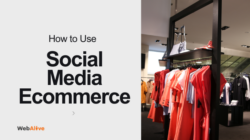
5 Ways to Provide Your Customers with Safe Online Shopping Experience
It only takes one mistake and one bad day to ruin an ecommerce shop when its customer data gets stolen. When that happens, you can be liable for any losses they incur, damages beyond those losses, fines, and costs to secure your business.
A hacker that gets inside your system can interfere with your business, shut it down immediately, or slowly continue to access customer payment and personal data over an extended period. They may also extort you, locking your site and encrypting files unless you pay a ransom. Many businesses don’t recover.
So, protecting your customers with a safe online shopping experience is just one part of protecting your business at large. Here are the five places to start.
1. Pick a safe ecommerce platform
If you’re building a new ecommerce shop or expanding a current one, there are some significant benefits to using or moving to a secured ecommerce platform instead of building your website from scratch. Services like Shopify web design, WooCommerce and Wix power millions of websites, and their mission is to make it as safe and easy as possible to sell goods and keep operations safe.
There are plenty of tools and plugins you can use for these platforms to manage inventory counts, web pages, shopping carts, payment, and more. There are many popular solutions, and users provide reliable reviews on what is or isn’t working. Choosing a platform makes it simple to find supported systems for protecting a wide range of business activities, especially payment and user data.
Platforms also make it easier for you or your designers and developers to manage all of the different ecommerce tools you need to succeed.
2. Update platforms, plugins, and more
Speaking of tools, you’ll likely be using a lot to manage your ecommerce store. There are plugins and add-ons to help you minimise spam and control user comments, migrate and backup your site, duplicate pages, create marketing, track Google Analytics, manage user accounts and shopping carts, and much more.
These all need to be kept up-to-date. Replace plugins and tools if their developer no longer supports and maintains them. When you’re running an older version, there’s a chance someone has discovered a vulnerability and can use that to access your site and customer data. Outdated options may also fail to use the latest security techniques, leaving a gap in your security.
Keep customers safe by controlling your website and minimising the places people can use to access it maliciously.
3. Adopt HTTPS
Hypertext Transfer Protocol Secure (HTTPS) is the new standard for websites and secure communication over the Internet. It’s one of the easiest things to get for your site and goes a long way to keeping you safe.
You can quickly see if a site has HTTPS enabled by the lock icon next to the URL in your browser. Many browsers like Chrome now also warn visitors when they’re going to a site not protected by HTTPS. You can get it either through your hosting company or from a platform like Shopify or Squarespace if you use them to create and manage your site.
Enabling HTTPS requires you to get a Secure Socket Layer (SSL) license — check out the WebAlive SSL explainer. That combination not only keeps your visitors safe and makes it less likely that someone can steal communications (like credit card numbers), but Google will also rank you higher for having them.
4. Use a secure payment gateway
Third-party payment gateways help you take a wide range of payments from your customers without having to store their credit card and payment information after the transaction completes. This protects them by minimising where their data is stored on the Web and protects you by minimizing risks from outside attacks.
Gateways route transactions through a certified payment partner, and that handles all of the encryption and verification of payment. It’s possible to do it yourself, but that requires significant investments in time and capabilities to store, process, and encrypt payment information. Running your own processing also requires you to meet significant compliance requirements that can vary by where you and your customers are located.
There’s an added bonus here, however. Popular gateways such as PayPal can instil an air of confidence in your customers that your store is reputable and that the transaction will be safe. That can help someone take the plunge and make their first purchase.
5. Vet any outside partners
It’s incredibly easy to outsource parts of an ecommerce business. You might focus on reselling products or using affiliate links to minimise your overhead. Some companies will outsource marketing and sales to third parties to keep up with the latest trends. For many, website developers and designers are contractors, not staff. And, you can also outsource your order management and fulfilment to third-party logistics companies, called 3PLs.
Anyone who is accessing your company’s site or data could potentially be a threat to customers. One of the biggest examples of this that people still talk about is the 2013-2014 hack of Target, where the attackers broke in via an HVAC subcontractor. It’s likely that few people thought about the company’s access as a potential threat, but it was all that was needed for the breach to occur.
If you’re outsourcing or getting help, vet these companies carefully. When you add a plugin or get third-party support, vet these brands and services too. When in doubt, rely on proven companies and tools. Ask other ecommerce stores and read reviews in seller platforms. Get an idea of how they keep you safe and how this extends to your customers.
Many smaller ecommerce stores will find it worthwhile to hire someone to help them integrate their many tools. Ask this vendor for their policies on vetting services and consider hiring them for additional work to review your technology stack and make recommendations for people and policies to secure your site.
Make your policies and communications transparent
There are nuances to what people include when thinking about making a website “safe” for ecommerce. Not only should you be protecting customers from outside threats and harm, but you want them to feel safe shopping for your site.
So, our final tip to help you safeguard your customers and revenue is to communicate early and often with customers. Show them everything you think they’ll need plus what they ask to see. That means keeping your returns and refund policy clear and easy to understand. Link to it on every sales page or put it in your footer. If you’ve got complex shipping policies, do the same with that explainer.
If you get a lot of traffic and have happy customers, consider adding a place for people to write reviews and rank products. Make it easy for other shoppers to help a potential customer decide to click that “buy” button.
When you’re transparent with potential customers, they’re more likely to trust you. Doing that work makes it easier to build the trust needed to provide you with an email for a discount or use your payment methods to complete a purchase.
Make people feel safe while also keeping their information secure, and you’ll be on the right path for ecommerce growth.
You read a lot. We like that
Want to take your online business to the next level? Get the tips and insights that matter.

